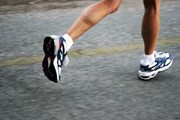
Running, after-all, is a non-contact sport; right? Well, yes and no.
Running is a great way to get exercise and to stay in shape. However, avid runners have one of the highest injuries rates in all of sports. Why you may ask? Running, after-all, is a non-contact sport; right? Well, yes and no. Obviously you’re not going to get tackled when you go for a run; or at least we hope not. But, running does indeed involve contact with what we call ground reaction forces. Understanding what these ground reaction forces do to the body over a course of a long run, or after weeks and months and years of running; will help you train better to minimize the stress that goes through your body. This hopefully will help you prevent those nagging injuries that tend to be all too common in avid runners. So whether you call yourself an avid runner, a casual runner, or someone who is planning to start a running program; you want to read our Top 10 List below on things you can do to help prevent injuries.
- Progressive Training
Don’t try to do too much too fast. If you’re new to running, start out with a program that progressively ramps up your distance. The same is true for avid runners returning from an injury. If may take some time to get back to the mileage that your accustomed to.
- Foundational Fitness Level
Running has a high physical demand on the body. Single leg support coupled with linear momentum needs adequate strength and flexibility to absorb force. Force = Mass times Acceleration. Thus, one’s mass (i.e. body weight) will have a factor in how the force is distributed. Simply put, some people should not begin running at the beginning of a weight management program. Instead, a cardiovascular activity with high metabolic load can be chosen that does not involve ground reaction forces and linear acceleration. This would be recumbent bikes or ellipticals where weight bearing is minimized. Seek professional help to determine the best way to begin a weight management program.
- Buy the right shoes
Good equipment is essential to success. Find out your foot type and purchase quality shoes. Also, track your mileage and change out your shoes every 300-400 miles.
- Learn a proper warm up routine
Warming up before you go for a run is a must! You want the warm up to by dynamic, not static stretching.
5. Learn proper form and technique
This can be vitally important that you take the time to research and learn proper form and technique. Things like stride cadence, foot contact, arm drive, and visual gaze … can all be things that the average or amateur runner would not consider or even know exists. After all , how hard is it to just go run? Well, as it turns out, there is much to be learned in the sports science world that can help you prevent injuries.
- Don’t forget RECOVERY!
This might be the most important component of your run. Most people at least know about warming up ; but what about recovery. After a 3-5 mile run, what do you do to recover? What do you do to restore your body’s range of motion in all 3 dimensions. What about the proper nutrition after a run? All of these are factors to consider to help avoid injury and to prepare your body for the next run.
- Cross – Train in 3 Dimensions
Running is a great sport. However, just like every sport, running has a pattern. That pattern is straight ahead and in a compact zone of motion to remain efficient. Runners need to have their bodies expanded to the end range of motion in their hips, spine, thorax, and shoulders. Otherwise, things get “tight”, or patterned into one direction of motion. Thus, it would be good to have a strength program that cross trains the body into other dimensions.
- Train single leg balance
Running is essentially a single leg squat, followed by another single leg squat, followed by …. Etc….
Therefore, runners need to have impecable balance. Balance on one leg that is strong enough to control their mass and momentum. Balance that can utilize ankle to knee to hip to core strategies.
- Nutrition is important
Running demands considerable energy expenditures, it is a high metabolic activity. Therefore, the body needs to be fueled to do so. Learn about proper nutrition to ensure you have the fuel to run. And don’t forget about proper hydration and recovery nutrition.
- Don’t look down
Now this doesn’t mean never … but don’t make it a habit to run with your head down. Your eyes are very powerful in controlling muscle tone throughout your body. Running with your eyes down, is like driving with the parking brake on. This creates increased back tone and will lead to muscle imbalances in your body. We want your eyes up and engaged in the environment. This spatial orientation allows your body to be more free and disperse muscle tone more evenly in your body.
For more information – ask your Physical Therapist at Spine and Sport
All rights reserved – ISPI 2007-International Spine and Pain Institute
Disclaimer: This content is reviewed periodically and is subject to change as new health information becomes
available. The information provided is intended to be informative and educational and is not a replacement for
professional medical evaluation, advice, diagnosis or treatment by a healthcare professional.


